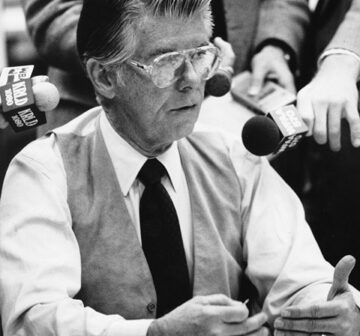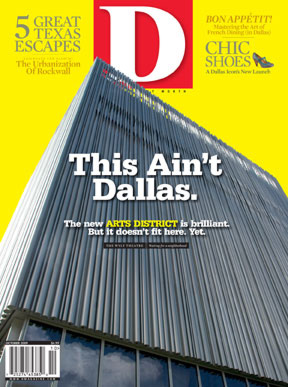
Meanwhile, the symphony association has its own timetable of preparations for the crucial August 3 vote on construction funds for the concert hall. I.M. Pei’s design has been transformed into a scale model that, as of early April, was still a deep, dark secret—to all but the symphony’s biggest potential contributors. “It can get people to feel that they are kind of special, and they are getting a special look, and therefore they should give a special contribution,” Galland explains. Philip Montgomery’s son, also named Philip, is in charge of the public relations campaign for the bond issue and is not taking passage for granted; the symphony will run a full-fledged political campaign this summer, as it should have in 1978. It would seem crazy for the voters to reject construction funds after approving the arts district in the 1979 referendum, but stranger things have happened.
While the symphony bites its nails, the Dallas Opera is mostly a spectator this year. It needs a bigger stage than the Music Hall can provide, but the symphony’s departure from Fair Park would, at least, ease its scheduling problems. It has not begun fundraising for a new site, and Lucy Billingsley says that if the city wants to put an opera house on her land at Routh and Flora, it should plan to buy the property from her.
The private developers, meanwhile, are reevaluating their previous plans, trying to cope with the aesthetic demands of the arts district and the economic realities of downtown development—which seems to be entering a slowdown that could last two to four years, by some estimates.
Several of the owners don’t yet know exactly what land they eventually will develop. Tishman and the city are in the midst of appraisals comparing Tishman’s property near the symphony—which needs an extra acre to accommodate Pei’s grand plaza—with the city’s land at Harwood and Woodall Rodgers. When the appraisals are complete, Tishman will swap some of its land for some or all of the city’s on a dollar-for-dollar basis. Tishman and Triland are talking about swaps or joint ventures also, since each will end up with property virtually in the middle of the other’s.
===There could be a revolt. If not by Lucy Billingsley, then by citizens such as John Leedom, a state senator and former City Council member who manages 2 acres of land at Ross and Central Expressway. “We aren’t interested in being in the arts district, and hopefully won’t be,” he says, adding the city should walk softly when it “starts talking about great plans with other people’s money.”!==
A few of the potential quagmires appear more treacherous than the land swaps, which really depend only on mathematics. The underground parking garage, for instance, is a technical challenge that would solve a lot of problems if it can be built. It would save the view, save space, and save money since nighttime and daytime activities would use the same lot, reducing the overall need for parking. “It’s really critical in my view,” Schoop says. “Without it, we won’t even have a district. It’ll just be cars and garages all over the place.”
Then there’s the matter of whether Lucy Billingsley’s 9.5 acres east of Routh—and, of course, the land of the smaller property holders who are her neighbors—should be in the district. In March, Billingsley balked at joining the district before knowing what restrictions might be imposed on property within its boundaries. After someone leaked an internal memorandum criticizing her father, Trammell Crow, the city sidestepped the question by saying that the master plan should determine what property the arts district needs. Most of Billingsley’s fellow developers say they do not think that her property is crucial to the success of the district; the city planning staff evidently thought that it was. What if the master planner agree with the city?
There could be a revolt. If not by Billingsley, then by citizens such as John Leedom, a state senator and former City Council member who manages almost 2 acres of land at Ross and Central Expressway. “This is about as near to the arts district as RepublicBank,” Leedom says. “We aren’t interested in being in the arts district, and hopefully won’t be.” And, he adds, the city should walk softly when it “starts talking about great plans with other people’s money.”
Leedom even worries that the park areas of the district could become a problem in their own right. “One of the sad things about my tenure on the council was the number of people wanting us to close some of these little neighborhood parks, because of the effect they were having on the peace and tranquility of the neighborhoods,” he says.
Harlan Crow worries about height restrictions; Webb Wallace says the issue of whether Flora Street should be pedestrian, automobile oriented, or both may “seem like a big issue,” but probably won’t be.
And there is the question of the delicate personal relationships among everyone involved in the planning process. The flap over criticisms made of Trammell Crow by Schoop and Assistant City Manager Vic Suhm briefly paralyzed the negotiations. Harlan Crow says he likes the two memo writers, and blames the Dallas Times Herald for the disturbance, saying, “Journalism is too good a word for that stuff.” But his father says, “I have no grudges against the Times Herald. The Times Herald was just doing its job, printing the news.” Trammell Crow says he is upset with Suhm. Schoop says, “I think we’re holding together pretty well.” His boss, City Manager Charles Anderson, says, “I see the issue as being resolved. I don’t see a feud.”
Leonard Stone, speaking from the symphony’s perspective, feels that none of the disputes so far are anything to be alarmed about. “This is a daring plan,” he says. “Few cities in the world have had the ability or the desire to stake out an area of downtown that is growing as vitally as Dallas and to dedicate it to the arts. And what is happening now should be happening now. The disputes are coming out. This is when it should be happening. This is the planning stage. So while the reading public may view it as dissension, I view it as absolutely necessary.”
Stone has a vested interest in optimism, but he also has a point. The developers, the city, and the arts institutions agree on most of the important issues. Each of the private landowners already has voiced strong agreement with the general arts district concept, and each has agreed to donate $20,000 to the planning process.
Each also has announced a willingness to sacrifice some building size in order to create an eye-pleasing district. Harlan Crow plans to use only one-third of his 90,000-square-foot lot across from the museum for construction. The rest, he says, will be used for “a park, a plaza, whatever is suitable.” On the other side of Flora, opposite the museum, the joint venture of Luedtke, Aldridge, Pendleton, and the Young-Gentek Company is planning to build an office building of 650,000 square feet, at most. Under the city’s zoning laws, they could build up to 840,000 square feet.
“Everyone is expecting to give a little,” says Webb Wallace. He thinks the interests of all parties in the project are so similar that any problems are bound to be solved. “I do not think that there is a conflict between a good arts district and what will make the developers happy,” he says. “Everyone wants an exciting district. … We want Flora to be something special that will attract the kind of activity that the district needs.
“Everyone wants the district to happen. Everyone realizes that it’s best for us individually. It’s best for the city. It’s best for the populace if there is an arts district. If there is to be an arts district, everyone will have to give a little to make it.”
George Rodrigue is now the managing editor of the Dallas Morning News.






